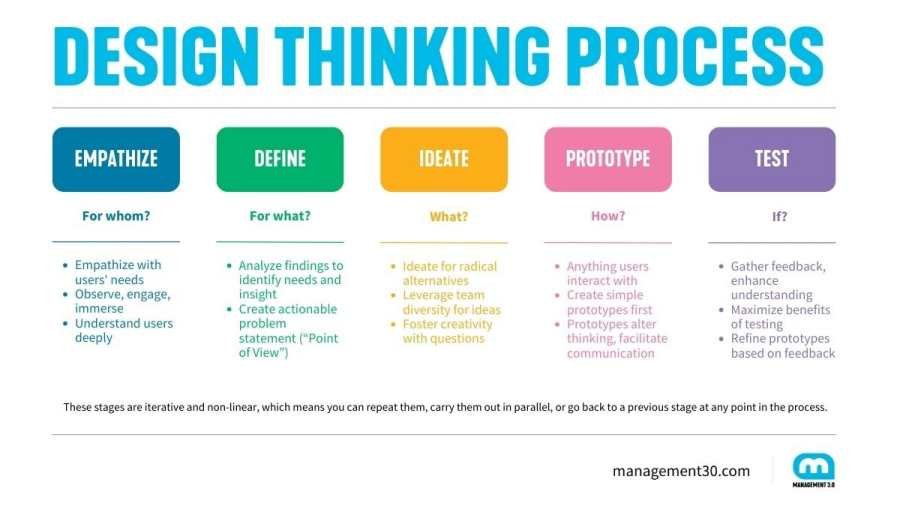
Innovation Through Design Thinking
Table of Contents
Innovation Through Design Thinking: Transform Ideas Into Reality
Hello, Future Entrepreneur!
Welcome to this comprehensive, personal guide where I’ll walk alongside you to create meaningful innovations by blending the proven design thinking process with a deep understanding of your skills, resources, and limitations. If you’re eager to build something impactful but wonder how to ground your ideas in reality, this expanded framework is for you.
Why This Expanded Design Thinking Framework Works for You [ Innovation Through Design Thinking ]
- It centers innovation on real user needs.
- It respects your skills and limits.
- It encourages iterative progress—not perfection upfront.
- It helps you innovate sustainably in your context.

What Is Design Thinking Process—and Why Should You Care?
Before we dive in, let me briefly explain what design thinking means. It’s a human-centered approach to problem solving that starts with understanding real people’s needs, followed by creatively brainstorming solutions, prototyping those ideas quickly, and testing them repeatedly to learn and improve.
At its core, design thinking involves five key phases:
- Empathize – learn deeply about your users and their problems.
- Define – clearly frame the problem or challenge based on what you’ve learned.
- Ideate – brainstorm a wide range of creative solutions.
- Prototype – build simple, testable versions of your ideas.
- Test – try out your prototypes with real users, gather feedback, and iterate.
It’s not a linear process—you often cycle back and forth between these steps, learning and improving continuously.
What I’m offering here is an expanded design thinking guide—one that integrates a vital but often overlooked element: your personal capacity. This means factoring in your skills, passions, resources, and constraints at every step to ensure you’re innovating within what’s truly possible and sustainable for you.

Step 1: Your Initial Spark — What Excites You? [ Innovation Through Design Thinking ]
Every journey starts with curiosity or a burning interest. Ask yourself what problems or ideas you feel drawn to explore. This spark is a compass that will keep you motivated when challenges arise.
Why start here?
Because innovation without passion is hard to sustain. Your enthusiasm fuels persistence.
Example:
You may be passionate about healthy living and local food, envisioning a new kind of meal kit tailored to busy urbanites.
Step 2: Self-Assessment — Discover Your Personal Capacity [ Innovation Through Design Thinking ]
This step is your reality check. Take stock of your:
- Skills & strengths: What talents do you have? Cooking, marketing, design?
- Resources: What time, money, equipment, and connections can you access?
- Passions: What keeps you motivated?
- Constraints: What holds you back?
Why this matters:
Working with what you have prevents burnout and sharpens innovation by turning limits into creative advantages.
Example:
A small workspace might inspire you to create single-portion meal kits instead of bulk cooking.
Step 3: Empathize — Understand Your Users Deeply [ Innovation Through Design Thinking ]
Empathy means stepping into your customers’ shoes to see the world from their perspective. This is the foundation of design thinking.
Methods include:
- Interviews and surveys
- Observing user behavior
- Immersions in user environments
Why?
Only by truly understanding your users’ pain points and desires can you create innovations they will love.
Example:
You learn that while meal kits exist, your users crave local flavors and sustainable packaging—needs unmet by current products.
Step 4: Define — Pinpoint the Real Problem with Your Innovation Angle [ Innovation Through Design Thinking ]
Here, you synthesize your learnings into a clear problem statement and identify what innovative twist will make your product stand out.
Also, consider if this challenge fits your capacity.
Why?
A clear focus helps avoid distraction and ensures your solution is both novel and feasible.
Example:
You define: “Young professionals want healthy, affordable meal kits that reflect local culture and reduce waste.”
Step 5: Ideate — Brainstorm Creative Solutions and Feasibility [ Innovation Through Design Thinking ]
Now generate many ideas without limits—crazy, conservative, digital, physical—then narrow down those that you can realistically execute.
Why?
Innovation is the space where creativity meets practicality.
Example:
Ideas might range from meal kits with QR-coded recipe videos to pop-up community dinners.
Step 6: Prototype — Create Tangible, Low-Cost Models [ Innovation Through Design Thinking ]
Build quick and simple mockups of your ideas to show users and gather feedback.
Why?
Early prototypes let you learn fast and cheaply without waiting for perfection.
Example:
Prepare a few meal kit samples and video tutorials for a weekend taste test.
Step 7: Test — Learn from Real Users and Iterate [ Innovation Through Design Thinking ]
Collect honest, detailed feedback and observe user interactions. Refine your product accordingly, always within your means.
Why?
Testing reveals hidden problems and helps you improve your innovation incrementally.
Example:
Users suggest smaller portions and clearer video instructions, which you incorporate.
Step 8: Launch & Monitor — Bring Your Innovation to Market and Grow [ Innovation Through Design Thinking ]
Launch your tested product with a simple, focused go-to-market plan. Monitor customer satisfaction and sales to keep improving and explore scaling opportunities.
Why?
Launching is not the end; it’s the start of a cycle of learning and evolving.
Example:
You sell meal kits via social media and local events, collecting monthly feedback for new ideas.
Ready to Start?
Innovation isn’t reserved for experts or inventors with massive resources. It’s a mindset and method you can cultivate. Use this guide as both a compass and toolkit—and take the first step today.
REFERENCES
- IDEO U: 7 Steps of the Design Thinking Process (Updated 2025)
- Interaction Design Foundation: The 5 Stages in the Design Thinking Process
- Harvard Business Review: Design Thinking Comes of Age
- ITONICS: Design Thinking: Definition, Tools, and Examples
- Stanford d.school: An Introduction to Design Thinking
More Stories
- Opportunities and Challenges of Entrepreneurship | Global World
- Talisay Coastal Cleanup | Negros Power Ignites Hope and Action
- Typhoon Crising: Negros Power’s Emergency Response
- Strategic Content Creation & Storytelling
- Starting a New Business: A Practical Guide for Beginners
- Foundations of Innovation Management
- Digital Marketing, Public Relations | The Fundamentals
- Anti-Pilferage Drive | Negros Power Slashes System Losses
- Personal Power: Stabbed but Still Slaying
- Mister Supranational 2025: France Triumphs, Philippines is 4th RU




![[ Innovation Through Design Thinking ]](https://www.fabasianlifestyle.com/wp-content/uploads/2023/11/dusit-thani-mactan-cebu-resort-dining-tradewinds-cafe-daytime-900x600.jpg)
![[ Innovation Through Design Thinking ]](https://www.fabasianlifestyle.com/wp-content/uploads/2023/11/dusit-thani-mactan-cebu-resort-dining-tradewinds-cafe-interior-900x559.jpg)
![[ Innovation Through Design Thinking ]](https://www.fabasianlifestyle.com/wp-content/uploads/2023/09/quan-cafe-5083130_1280-900x600.jpg)



